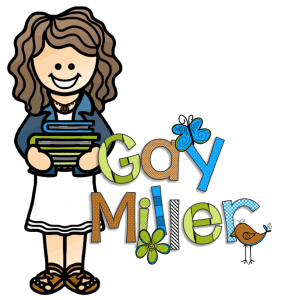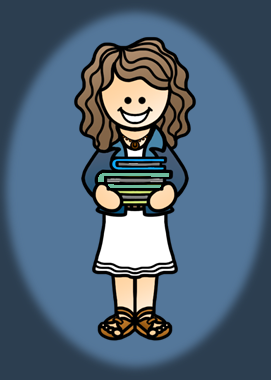
Teaching character traits is a must. When students know what details to look for in characters in literature, they will better understand the text and will become better writers as well. This post provides student-friendly definitions. It also gives some teaching ideas with handouts to try out in the classroom.
Defining Characters
When writing a story, an author usually begins with physical descriptions of the characters. The author must then go a step further to describe the personality of each of the characters. The characters need to have both positive and negative qualities to make them seem realistic. Good authors do not simply list character traits. They show the personalities of the characters through actions.
Types of Characters
Protagonist vs. Antagonist
The protagonist is the main character. The character that causes conflict against the protagonist is called the antagonist.
Round vs. Flat
- A round character is one whose personality, background, motives, and other features are fully described or explained by the author.
- A flat character is one who is not fully described but is useful in carrying out some narrative purpose of the author. They tend to be minor characters.
- To remember round and flat characters think of a basketball. The information you know about a character is like the air going inside the ball. If you know only a little, you would not be able to put much air inside the ball; therefore, it would be flat. However, if you know a lot of information you would be able to put a lot of air inside of the ball. The ball would become inflated and round. Therefore, if a character is round, readers know a lot about him/her.
Dynamic vs. Static
- A dynamic character is one who goes through a personality change due to the events in the story.
- A static character is one whose personality does not change throughout the story.
- In most books, the main character is both dynamic and round.
Get the blog post handout with the definitions found here and printable activities.
Question Stems for Character
- Who is the main character in this story?
- Describe the main character’s traits in this story.
- How do the main character’s actions help you determine his/her traits?
- What did the actions of the character reveal in paragraph ___?
- How does the main character change within the selection?
- What can you tell by the character’s response?
- What do the character’s thoughts show?
- How does the character change from the beginning to the end of the story?
Teach Character Traits
Activity #1 – Character Silhouettes
This simple no-prep method is both engaging and fun for students.


Idea #1 – Silhouette with Rays
Students draw a silhouette figure in the center of their page. Out of the silhouette, students draw rays. In each shape formed by the rays, students write facts about the character.
Idea #2 – Silhouette Figure
Students choose one character from the book or story they are reading. They draw the character as a silhouette covering the entire piece of paper. On the body of the character, students describe the character. On the arms and legs, students list four actions.
Idea #3 – Inner and Outer Traits
Students copy the boy or the girl silhouette in the center of the page. Students then write a paragraph describing the character’s physical features. This includes coloring – hair, eyes, etc.; size – tall, short, thin, muscular, etc.; and distinguishing features – mustache, curly hair, etc. on the left side of the figure. On the opposite side of the character, students describe inner character traits. This could be in the form of a paragraph or a list of adjectives such as absent-minded, disrespectful, humorous, immature, etc.
Idea #4 – Comparing Two Characters
Students create two overlapping character shapes to form a Venn Diagram. Students then compare and contrast the two characters by telling how they are different and alike.
Idea #5 – Silhouette House
Students draw a simple house structure. The house needs six windows. In each window, students answer Who? What? When? Where? Why? and How? to explain how a specific character handled one situation in the story.
Activity #2 Animated Shorts
Teaching using animated shorts is always a hit with students. The animated short film Geri’s Game is a fun way to teach about character traits as Geri “becomes” two characters in the film.
Activity #3 Teaching Character Traits with Interactive Notebooks
I like students to keep a journal-type notebook. The notebook is divided into sections for each novel study. Students write reactions to the story, answer constructed response questions and other novel-specific activities. This is a great place for students to write character descriptions. Below are ideas to make this activity more fun for students.
Idea #1 – Cards
This simple idea can be used with any novel. Take a piece of colored copier paper and cut it in half vertically, so you have two 8.5 by 5.5-inch rectangles. Fold each of these in half creating a card. Students draw a character on the front and write a description inside. This is great when the novel has many characters that are difficult to remember.
Idea #2 – Pop-Ups
For this activity, students draw characters from the waist up on heavy-weight paper or cardstock. Next, they write descriptions on index cards or rectangle pieces of heavy-weight paper or cardstock. The drawings and the descriptions are glued onto a notebook page so the character can ‘stand up’ or ‘fold down’ when put away.
Idea #3 – Pyramids
This activity is a fun way to teach inner and outer character traits.
Students illustrate the character on one face of the pyramid. On the next, they write a physical description. On the final triangle, students list inner traits.
This pyramid folds down flat for storage.
Activity #4 Teaching Character Traits with Printable Organizers
In the handout, you will find 3 printable organizers for students to write character descriptions.
Get all printable activities from this post here.
Activity #5 Teaching Character Traits with Anchor Charts
How easy is this? With just 2 or 3 minutes of preparation, you can have this activity ready to go.
Draw an outline character on a large piece of paper. As students name character traits, write them around the outline character shape.
Venn Diagram
This anchor chart size Venn diagram is found in the printable along with detailed instructions on how to print it in the large picture size shown here.





6 comments
Skip to comment form
Great article.
Pretty! This has been an incredibly wonderful post. Many thanks for supplying
this info.
Saved as a favorite, I love your website!
Excellent blog post. I definitely appreciate this site. Continue the good work!
I am using the character chart graphic organizer in my 6th grade special education classroom today! Thanks for posting!
Author
You’re welcome.